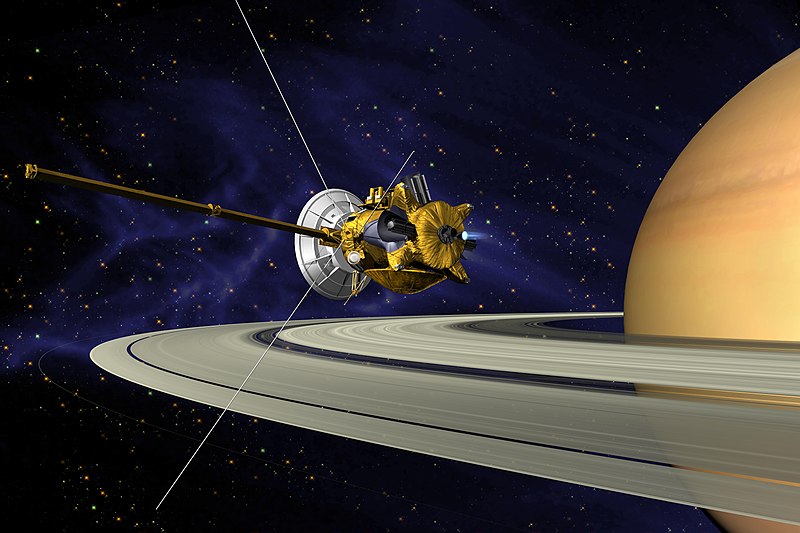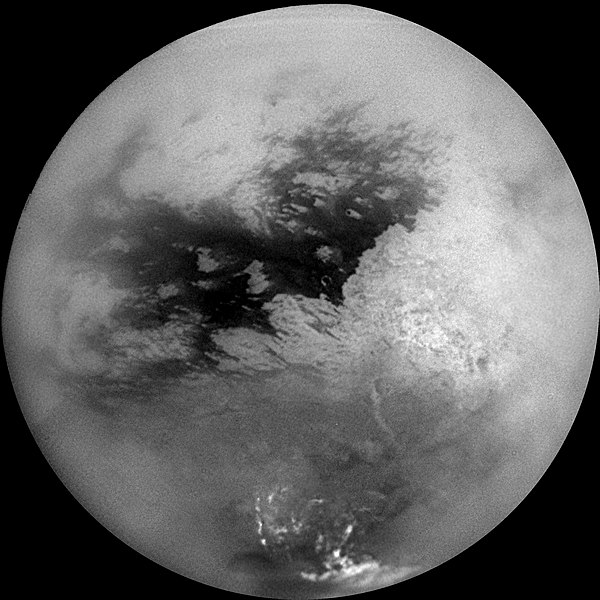Conceção artística da(s) sonda(s)
A sonda Cassini-Huygens é um projeto conjuntoo da ESA e NASA para estudar Saturno e as suas luas através de uma missão espacial não tripulada. A nave espacial consiste de dois elementos principais: a Cassini Orbiter e a Sonda Huygens. Foi lançada a 15 de outubro de 1997 e entrou na órbita de Saturno no 1 de julho de 2004. Foi a primeira sonda a orbitar Saturno.
Fotografia de Titã
Passagens por Titã
A sonda Cassini teve o primeiro dos seus numerosos encontros com Titã a 2 de julho de 2004 numa aproximação a 339.000 quilómetros. As fotografias mostraram nuvens consideradas como compostas de metano e características da superfície.
Encontro da Huygens com Titã
A Cassini largou a sonda Huygens no dia 25 de dezembro de 2004. A penetração na atmosfera deu-se no dia 14 de janeiro de 2005.
Descoberta de lago líquido em Titã
Em 30 de julho de 2008, a NASA anunciou a descoberta de um lago líquido próximo da região polar sul destaa lua. O lago foi apelidadado de Ontario Lacus e é feito de hidrocarbonetos líquidos como metano e etano.
in Wikipédia
Cassini-Huygens mission facts
Exploring both Saturn and Titan, Saturn's mysterious moon
Name Christiaan Huygens (1629-1695) was a Dutch scientist who discovered Saturn's rings and, in 1655, its largest moon, Titan. Italian Jean-Dominique Cassini (1625-1712) discovered the Saturnian satellites Iapetus, Rhea, Tethys and Dione. In 1675 he discovered what is known today as the 'Cassini Division', the narrow gap separating Saturn's rings.
Description Cassini-Huygens is a joint NASA/ESA/ASI mission. NASA’s Cassini spacecraft continues to orbit Saturn, making an extensive survey of the ringed planet and its moons. The ESA Huygens probe is the first to land on a world in the outer Solar System - on the surface of Titan, Saturn’s largest moon. Data from Cassini and Huygens may offer clues about how life began on Earth.
Launch 15 October 1997 (Titan-IVB/Centaur at Cape Canaveral, United States).
Status The spacecraft arrived at Saturn in July 2004. Cassini is in operation, orbiting around Saturn. The Huygens probe landed on Titan on 14 January 2005.
Journey The 5.6-tonne Cassini-Huygens spacecraft made four gravity-assist swing-by manoeuvres. These manoeuvres were: Venus (April 1998), Venus (June 1999), Earth (August 1999), and Jupiter (December 2000). In December 2004, towards the end of Cassini's third orbit around Saturn, the Huygens probe was ejected on a 22-day cruise to Titan. Huygens reached Titan on 14 January 2005.
Notes Cassini-Huygens is the largest interplanetary spacecraft ever built. Gravity-assists from two swing-bys of Venus and one of Earth provide the equivalent of 68 040 kilograms of rocket fuel.
During the long journey to Saturn, ESA scientists 'woke up' the Huygens probe every six months to check that all was well.
The Huygens probe can withstand temperatures of up to 18 000°C in front of the heat shield. The heat generated as Huygens travelled through Titan's thick gas atmosphere was immense.
Titan is one of the most mysterious objects in our Solar System. It is the second largest moon and the only one with a thick, methane-rich, nitrogen atmosphere. Experts think that its atmosphere resembles that of a very young Earth.
in ESA




Sem comentários:
Enviar um comentário